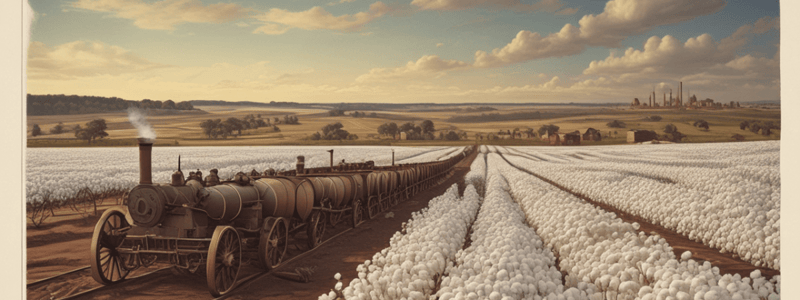Podcast
Questions and Answers
What was a key factor in the success of cotton?
What was a key factor in the success of cotton?
- The availability of expensive land
- The growth of a large labor force
- The invention of the cotton gin in 1794 (correct)
- The decline of the steam power industry
What was Thomas Jefferson's vision for the United States?
What was Thomas Jefferson's vision for the United States?
- A nation of urban dwellers and intellectuals
- A nation of wealthy landowners and aristocrats
- A nation of small farmers and families (correct)
- A nation of industrialists and factory workers
What was the consequence of the democratization of land ownership in the South?
What was the consequence of the democratization of land ownership in the South?
- The decline of the cotton industry
- The normalization of slavery as a tradition in the South (correct)
- The abolition of slavery
- The enrichment of Native American communities
What region was referred to as the 'Black Belt'?
What region was referred to as the 'Black Belt'?
What was the primary crop grown in the coastal regions of South Carolina?
What was the primary crop grown in the coastal regions of South Carolina?
What was the approximate year when steam power became widely available?
What was the approximate year when steam power became widely available?
What was the result of the combination of factors that led to the success of cotton?
What was the result of the combination of factors that led to the success of cotton?
What is depicted on the map published by the US Coast Guard?
What is depicted on the map published by the US Coast Guard?
Flashcards are hidden until you start studying
Study Notes
Cotton and the United States
- Cotton grew quickly on cheap, widely available land, especially Petit Gulf cotton.
- The invention of the cotton gin in 1794 and the emergence of steam power three decades later made cotton a common person's commodity.
- Cotton was key to the United States' westward expansion, realizing Thomas Jefferson's vision of a nation of small farmers.
Expansion and Slavery
- The democratization of land ownership led to the normalization of slavery in the South.
- Indian removal, federal auctions, credit, and the dream of cotton's immediate profit contributed to the growth of slavery.
- By the 1860s, slavery had become a deeply ingrained tradition in the South, leading to the split of the nation.
Map Analysis
- A 1860 map shows the percentage of slaves in the population in each county of the slave-holding states.
- The highest percentages of enslaved people were along the Mississippi River, in the "Black Belt" of Alabama, and coastal South Carolina.
- These areas were centers of agricultural production, specifically cotton and rice.
Studying That Suits You
Use AI to generate personalized quizzes and flashcards to suit your learning preferences.




